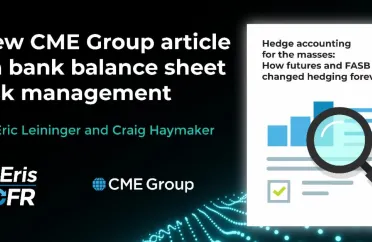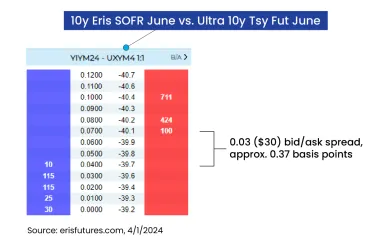
By Mike Vough – Vice President, Hedging and Trading Products, Optimal Blue
and Geoffrey Sharp – Managing Director, Head of Product Development and Sales at Eris Innovations
In both low and high origination environments, non-agency loans, such as jumbo, Non-QM, and Private-Label Security, are always flagged as potential growth areas for lenders. What has prevented these perennial projected growth areas from gaining steam?
Part of the issue holding back these types of loans from gaining more of a foothold comes down to the classic chicken or the egg causality dilemma. A liquid secondary market begets more production, and more production creates more liquidity in the secondary market. This situation is commonly seen in agency hedging when the market moves quickly, and new originations are slotting to coupons not yet liquid and commonly traded by broker-dealers. Originators must also deal with an opaque price discovery process due to the lack of a liquid secondary market. Could the lack of a trusted pricing strategy be leading to less origination, thus impacting the liquidity of the secondary market for these assets?
The lack of reliable pricing for bulk deals (or even in investor rate sheets) leads to originators using less sophisticated pricing strategies to price new originations that may not be fully grounded in reality. There is some convenience to pricing originations, bulk deals, and securitizations using the “finger in the air” approach of a simple spread over a selected US Treasury. However, this creates headaches for those trying to derive hedging strategies for short-term warehousing and longer-term investment strategies. If you cannot reliably and confidently price a loan, how can you hedge it with confidence? The flip side is that many vendors can supply complicated models with a great deal of flexibility, but the number of options and lack of tried-and-true strategies can leave lenders overwhelmed with too many options. Z-spreads, stochastic rate paths, Option Adjusted Spread (OAS), N-Spreads, and other modeling complexities add additional anxiety to this process.
If you made it this far, you may still be wondering what you can use to hedge these loans. Unfortunately, there isn’t a liquid jumbo forward contract available, like there is in agency originations. You could use Treasuries, but in addition to not having an embedded credit component, there is no way to build a tradable, forward term structure – a key component to financial modeling and loan pricing. It is unfortunate that U.K. regulators phased out LIBOR in June 2023, as it used to have a credit component with the capability to build a tradable, forward curve based on LIBOR swaps. Although to-be-announced (TBA) agency securities might seem appealing, despite their poor liquidity ever since the Federal Reserve stopped buying agency mortgage-backed securities (MBS), the risk characteristics of TBAs are not suited to pricing and hedging non-agency loans.
Click Here to Download the PDF...

Eris SOFR markets stay strong during $3B trading day Eris SOFR trading activity spiked notably on April 22, with 32,767 contracts ($3.3 billion notional) tradedActivity included more than $1.5B in outright 10y Eris SOFR (over $1.2mm DV01) and $1.5B in 5y Eris SOFR (nearly $700K DV01)Multiple participants called out the robustness of the Eris SOFR markets during this period, citing its capacity to take on large positions“On April 22, our team executed more than 30,000 Eris SOFR contracts for our clients,” said Rob Powell, Senior Managing Director of the Fixed Income Group at RJ O'Brien & Associates. “Eris SOFR markets remained solid throughout the day, and our clients were pleased with our ability to negotiate block-sized trades in line with transparent, electronically-posted prices.” Eris SOFR open interest surpasses 200,000Eris SOFR open interest recently surpassed 200,000 contracts ($20B notional), setting a new recordLaunched in 2020, Eris SOFR surged in trading activity and open interest in 2023 as SOFR replaced LIBOR as the pre-eminent U.S. interest rate benchmarkIn 2024, front month open interest is up 59% and overall open interest is up 19%Growth is focused in the 5-year and 10-year tenors, driven by new hedger clientsClick Here to Read More

Hedge accounting for the masses:How futures and FASB changed hedging foreverView ArticleWho should read it?Banks and credit union executives looking to use swaps and apply hedge accounting to manage interest rate risk What is it about?The authors show how advancements in trading swaps (Eris SOFR Swap futures) and applying hedge accounting (recent FASB guidance, especially the “Portfolio Layer Method”) combine to make hedging more accessible by decreasing the cost and complexity Don’t miss the hedge accounting case studiesJump to the last section to see case studies demonstrating ledger-level accounting detail for designating Eris SOFR Swap futures as cash flow and fair value hedges About the AuthorsEric Leininger is Executive Director of Research and New Product Development for Interest Rates and Equities for CME Group. The Research and Product Development team develops new risk management products as well as ensuring the continued relevance of CME Group's current suite of key benchmarks. The team also produces original research into derivatives and their underlying markets across asset classes and around the world.Craig Haymaker is a managing director with Eris Innovations, responsible for hedging solutions. Prior to Eris, he was a managing director with HedgeStar—an outsourced, back-office hedging provider—overseeing sales, marketing, and operations. Craig is a Certified Public Accountant whose career has been focused on risk management and financial products at Deephaven Capital Management, Deloitte & Touche, Liberty Mutual Group, and US Bancorp. Craig is also a board member with the Professional Risk Managers International Association (PRMIA).

Bid/ask spreads of Eris/Treasury futures Inter-Commodity Spreads (ICS) continued to tighten in March, with 10-year Eris SOFR vs. CME Ultra 10-year Treasury Futures 0.5 bp or tighter 42% of regular trading hoursThese ICS allow for trading swap spreads in futures form, with electronic execution in lots sizes of $100K notionalTo view market data, request the Eris ICS Bloomberg Launchpad, or visit erisfutures.com/live Click Here to Read More

3-minute video from CME Group gives overview of using Eris SOFR for hedging exposure to interest rates
Video shows a commercial loan example of a real estate developer borrowing money at a floating interest rate to fund a 5-year project, then using Eris SOFR to hedge against interest rate increases jeopardizing project profitability
It’s an excellent introduction for other hedgers, as well, (e.g., bank balance sheet, mortgage pipeline, mortgage servicing rights), as it covers the basics of Eris SOFR product design and futures market operation

Eris SOFR Swap Futures set records in March with average daily volume of 8,999 contracts and open interest of 101K (March 14)Growth was driven by the recent launch of swaps/futures portfolio margining (PM) and the migration from Libor to SOFRFollowing the quarterly roll, 100% of front-month activity now occurs in Eris SOFR rather than Eris Libor10 year Eris SOFR growth was particularly strong, with open interest now 20,240, and more than 10 clients using it for the first time2y and 5y Eris SOFR also saw strong growth, with 2y open interest now 31,988, and 5y OI now 20,499Click Here to Read More

CME launched Eris/Treasury Inter-Commodity Spreads (ICS) on Nov 13, allowing guaranteed order book trading of spreads between between Eris SOFR Swap futures and CME Treasury futuresThese ICS markets offer electronic execution of futures/futures swap spreads to dealers and other traditional swap users in:5y Eris SOFR vs FV7y Eris SOFR vs. TY10y Eris SOFR vs. UXYNascent liquidity in the ICS markets has already made an impact, with implied prices tightening Eris SOFR outright markets and spurring additional trading activityWant to see these markets in Bloomberg? Reply to this email to request the Bloomberg Launchpad for Eris ICS, and we’ll share it with youOpen interest +48%for 5y & 10y in the past year5-year and 10-year Eris SOFR open interest stands at 120,014 contracts as of Jan 17, 48% higher than combined Libor/SOFR OI at the start of 2023Growth reflects an increased number of swap users taking advantage of much-improved liquidity, fueled by CME’s February introduction of swaps/futures portfolio margining5-year Eris SOFR saw the strongest OI growth, increasing by more than 27,000 contracts during the period Click Here to Read MoreLoading...

Private lenders who borrow at floating rates indexed to the Secured Overnight Financing Rate (SOFR) and lend at fixed rates bear the risk of interest rate increases diminishing their net interest spread and impairing the resale value of the loan. Now, they can hedge this risk using Eris SOFR Swap futures (Eris SOFR) to match the rate terms of financing with the rate terms of the loan, offsetting losses from interest rate increases.
With Eris SOFR, private lenders can…
Expand product offering to include fixed rate loans, confidently lending at competitive fixed rates while borrowing remains indexed to SOFR.
Price loans to match hedges by referencing the transparent and executable Eris SOFR curve.
Hedge efficiently during loan aggregation in sizes as small as $100,000, allowing for more competitive bulk pricing.
Hold Eris SOFR hedges for the entire duration of on-balance-sheet loans (with no requirement to roll positions quarterly, unlike traditional futures) or lift hedges when loans are sold.
Track transparent pre-trade and post-trade prices, supporting efficient risk management and operations.
Download PDF
Learn more at CME Group

Simplifying bank and credit union access to FASB-eligible hedges
Higher interest rates and deposit instability highlight the importance of duration hedging. Eris SOFR Swap futures (Eris SOFR) provide banks and national credit unions (NCUs) the simplicity of CME Group exchange-listed futures to hedge exposures to interest rate volatility replacing cumbersome OTC interest rate swaps.
Exchange-listed futures: Transparent, low-cost alternative to OTC swaps
Hedgers use Eris SOFR as a preferred alternative to OTC interest rate swaps. As futures contracts listed by CME Group, Eris SOFR offers market participants the economic performance of a standard, fixed-versus-floating rate interest rate swap and the advantages of using U.S. futures:
Straightforward futures paperwork: No ISDA agreements with dealer counterparties
Trade using a traditional futures account and broker, the same workflow one would use to trade CME Treasury futures or three-month SOFR Strip futures.
Traditional pricing and operational simplicity: Reduce expensive overhead and risk management
View independent and transparent prices provided by CME Group, simplify settlement, cash processing, and obtain daily valuation and risk parameters in one easy solution. Execute electronically or via blocks to further refine hedges.
Capital-efficient futures margin: Post up to 65% less than cleared swap or uncleared margin
Save significant capital by reducing the amount of initial margin posted to collateralize positions.
Eligible for FASB hedge accounting (FAS-133/ASC-815)
Like interest rate swaps, banks and NCUs may use Eris SOFR Swap futures to reduce income statement volatility by applying fair value or cash flow hedge accounting.
Download PDF
Learn more at CME Group
